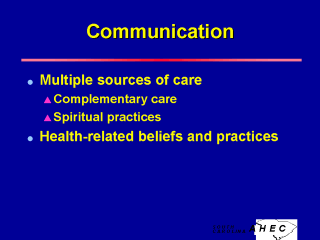| front |1 |2 |3 |4 |5 |6 |7 |8 |9 |10 |11 |12 |13 |14 |15 |16 |17 |18 |19 |20 |21 |22 |23 |24 |25 |26 |27 |28 |29 |30 |31 |32 |33 |34 |35 |36 |37 |38 |39 |review |
 |
Communication - Individuals may use many sources of care during a single episode of illness. Patients may see biomedical practitioners for relief of symptoms while simultaneously using complimentary medicine or spiritual healers to eliminate the cause of the illness. However, most are reluctant to communicate this information, so respectful communication about patient preferences and practices is crucial for adherence to biomedical treatment. - Complementary medicine refers to interventions for improving, maintaining, and promoting health and well-being, preventing disease, or treating illnesses that are not part of a standard biomedical approach. - Spiritual and religious practices are important in relation to improved outcomes, particularly with respect to end of life decisions. - All peoples have their own health-related beliefs and practices that influence how new ideas are accepted. They receive and interpret health messages within the context of their own beliefs. When new biomedical ideas are introduced to people who already have an established system, they are more likely to accept those that fit with the pre-existing system and reject those that do not. Health care belief systems are critical to the patientís healing process. |
| front |1 |2 |3 |4 |5 |6 |7 |8 |9 |10 |11 |12 |13 |14 |15 |16 |17 |18 |19 |20 |21 |22 |23 |24 |25 |26 |27 |28 |29 |30 |31 |32 |33 |34 |35 |36 |37 |38 |39 |review |